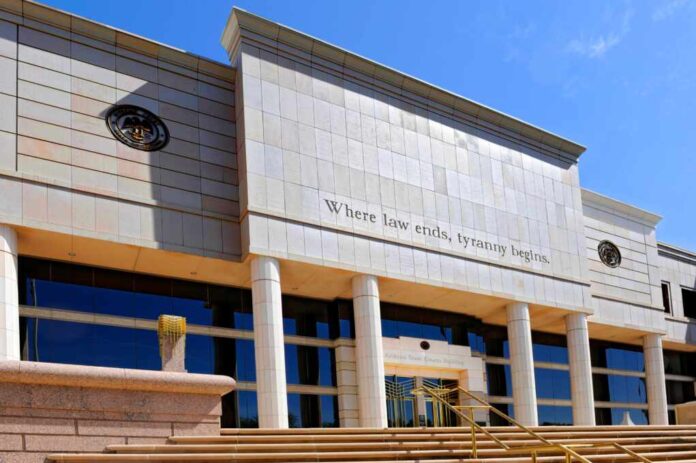
Arizona’s Supreme Court has introduced AI avatars to announce legal rulings, raising questions about technology’s role in the judicial system while officials insist human judgment remains at the core of decision-making.
At a Glance
- Arizona Supreme Court is the first state court system to use AI-generated avatars (Victoria and Daniel) to deliver news about court rulings
- The avatars can produce videos in about 30 minutes compared to hours for traditional videos
- Chief Justice Timmer emphasizes that content is written by justices themselves, not AI
- The initiative aims to rebuild public trust and make court decisions more accessible
- All AI-generated content clearly discloses the use of artificial intelligence
Bringing Technology to the Courtroom
The Arizona Supreme Court has taken a pioneering step by introducing AI-generated avatars named Victoria and Daniel to deliver news about court rulings. This marks the first time a state court system in the United States has employed artificial intelligence in this capacity. The digital spokespeople deliver information about cases ranging from arson to DUI, providing details about judicial decisions more efficiently than their human counterparts could. The court’s communications team uses a program called Creatify to create these avatars, which appear in videos summarizing court decisions posted on the court’s website and social media.
🇺🇸ARIZONA SUPREME COURT ROLLS OUT AI SPOKESBOTS
Meet Victoria and Daniel, the AI-generated avatars now delivering court rulings in Arizona.
The state’s highest court says they’re here to make legal decisions more accessible—but critics wonder if people will even trust them.… https://t.co/E3zEQ3Ev8A pic.twitter.com/uBNYSOup8O
— Mario Nawfal (@MarioNawfal) March 18, 2025
The avatars significantly streamline the court’s communication process. Videos that would traditionally take hours to produce now require only about 30 minutes to complete, allowing the court to disseminate information more rapidly. The characters’ names and appearances were carefully selected to represent Arizona’s diverse population, and each video includes a clear disclaimer about the use of artificial intelligence. According to court officials, this technological advance represents just the beginning, with plans to expand the avatars’ use for Access to Justice projects, community programs, and civics education.
Rebuilding Public Trust
The timing of this initiative is particularly significant as the Arizona Supreme Court works to rebuild public trust following controversial rulings, including a decision to enforce a Civil War-era abortion law. Chief Justice Ann Timmer has acknowledged the need for better communication about court decisions, especially complex or contentious ones. The avatars are part of a broader strategy to make the judicial system more transparent and accessible to average citizens who may not understand legal terminology or the reasoning behind certain rulings.
“We serve the public better by saying, OK, we’ve issued this decision. Now, let us help you understand what it is.”, said Chief Justice Ann Timmer.
The court is also exploring different emotional deliveries for the avatars and the possibility of Spanish translations to reach a wider audience. These efforts reflect a recognition that public confidence in the judicial system depends not just on making fair decisions, but on effectively communicating those decisions to the public. By making legal rulings more accessible, the court hopes to demystify the judicial process and strengthen democratic institutions that rely on public trust.
Human Judgment Remains Central
Despite the advanced technology, court officials emphasize that human oversight remains paramount. Communications Director Alberto Rodriguez, who helped design the avatars, stresses that AI is merely a tool to enhance efficiency, not replace human judgment. All content delivered by the avatars is written by the justices themselves, ensuring that the substance of court communications reflects human legal expertise and ethical considerations rather than algorithmic generation.
“I think it’s just an efficient way for us to get news out,” Communications Director Alberto Rodriguez said. “It’s really an opportunity for us to meet the public where they’re consuming their media.”, said Alberto Rodriguez.
This careful balance comes at a time when concerns about AI in the legal field are growing. Recent controversies include a New York plaintiff attempting to use an AI attorney and California’s state bar using AI to write exam questions. Legal experts have raised alarms about AI hallucinations and false citations appearing in legal filings. Chief Justice Timmer has explicitly stated that the Arizona Supreme Court’s use of AI is not generative and will not replace human judgment, drawing a clear line between using technology as a communication tool and allowing it to influence legal reasoning.
Future Implications
As AI applications continue to expand across various professions, the Arizona Supreme Court’s initiative represents a measured approach to integrating technology while preserving the essential human elements of the justice system. The court’s experience could provide valuable insights for other judicial bodies considering similar technologies. Some experts have suggested improvements, such as making disclaimers more prominent and designing avatars to better engage with viewers, indicating that this is still an evolving field with room for refinement.
“For years, we took it for granted that, ‘Of course you trust the courts, of course you trust judges.’ We’re doing our best and these are hardworking people,” Ann Timmer. “But if people don’t believe that, it doesn’t matter.”
The initiative reflects broader trends of AI integration across institutions while highlighting the unique considerations that apply to the judicial system. By maintaining a clear distinction between technological assistance and judicial authority, the Arizona Supreme Court is attempting to navigate the benefits of modern communication tools while preserving the human wisdom and ethical judgment that remain indispensable to the administration of justice. The success of this approach will likely depend on public reception and the court’s ability to use technology in service of greater transparency and trust.

























